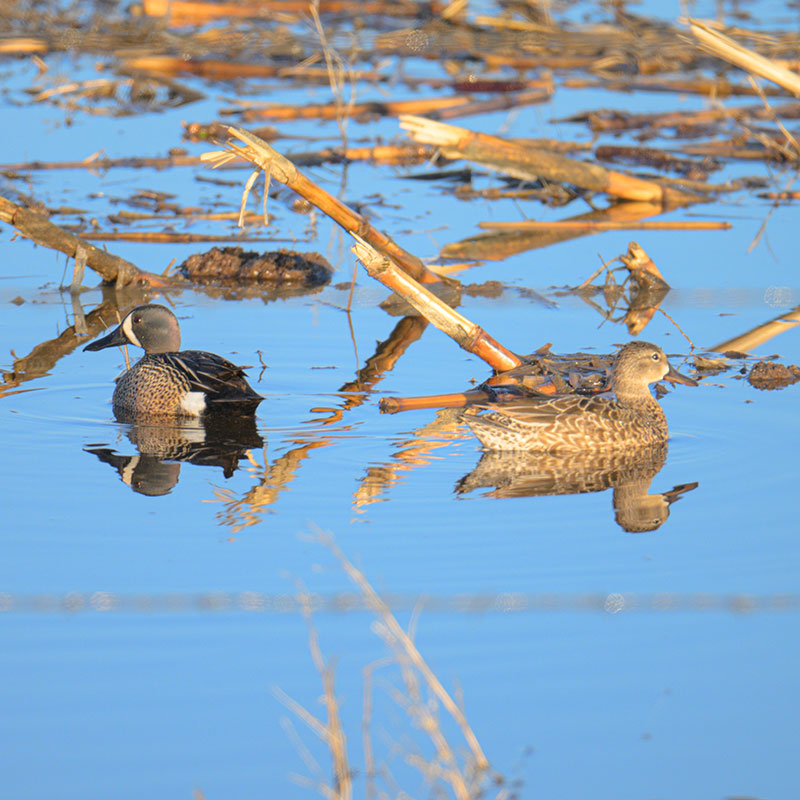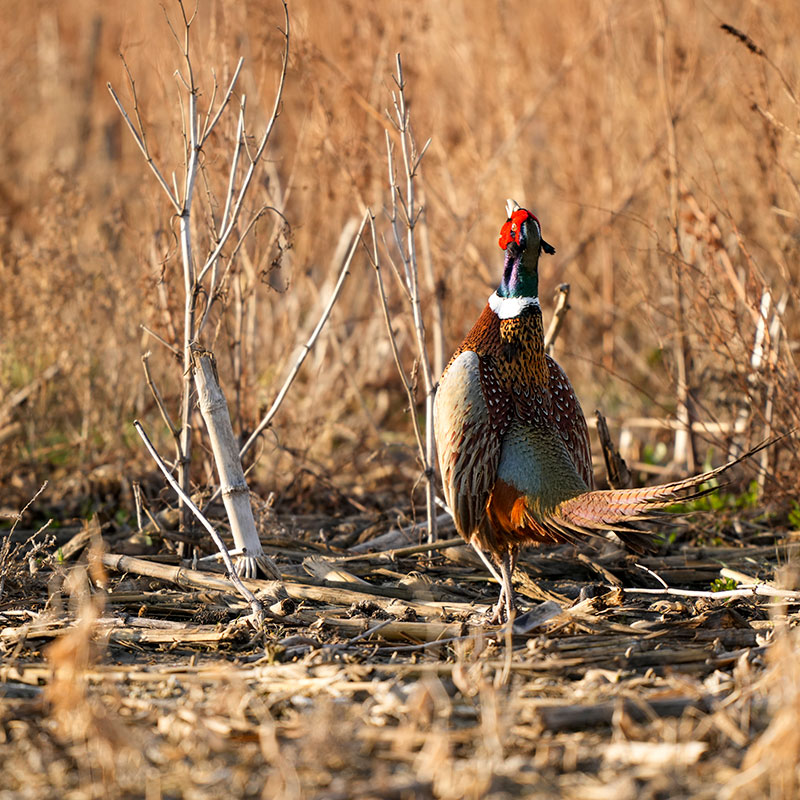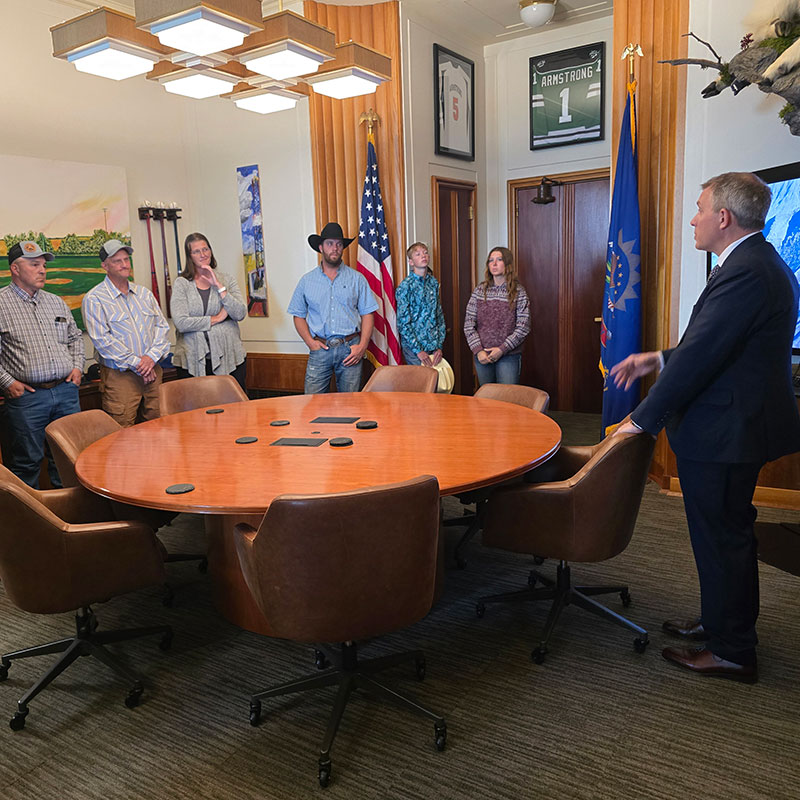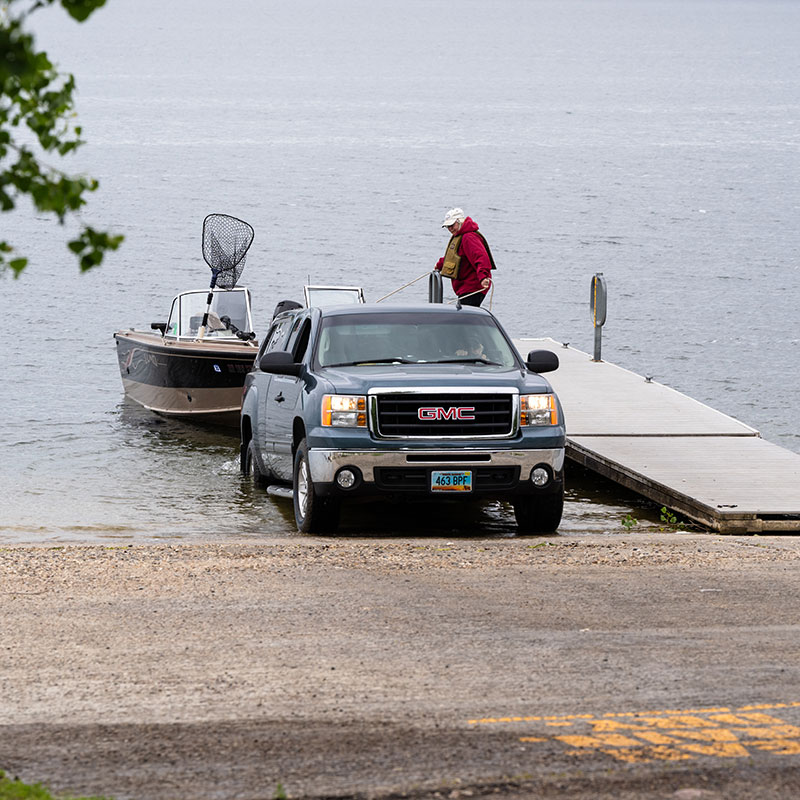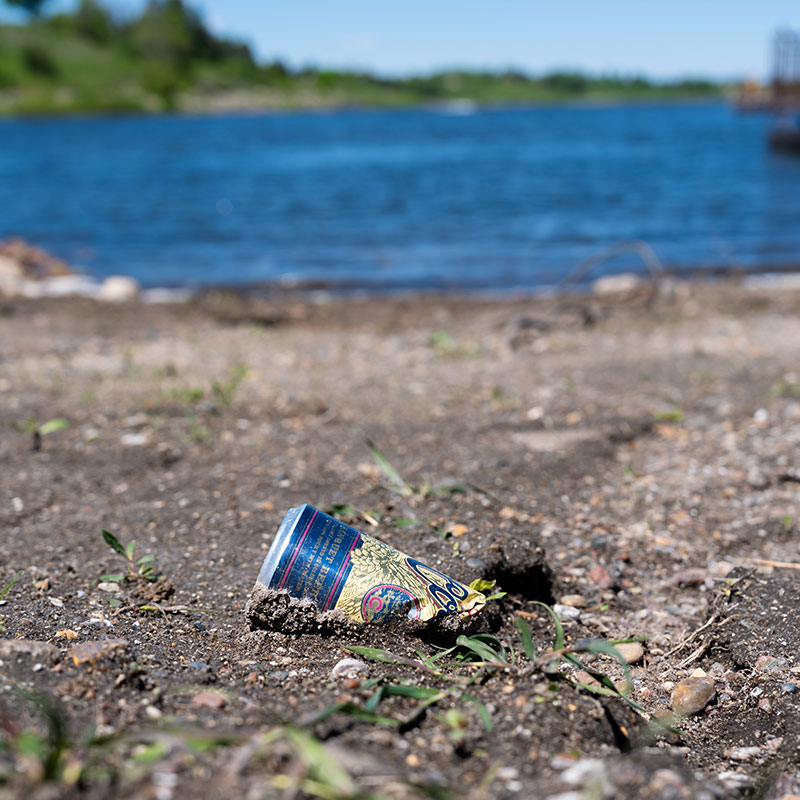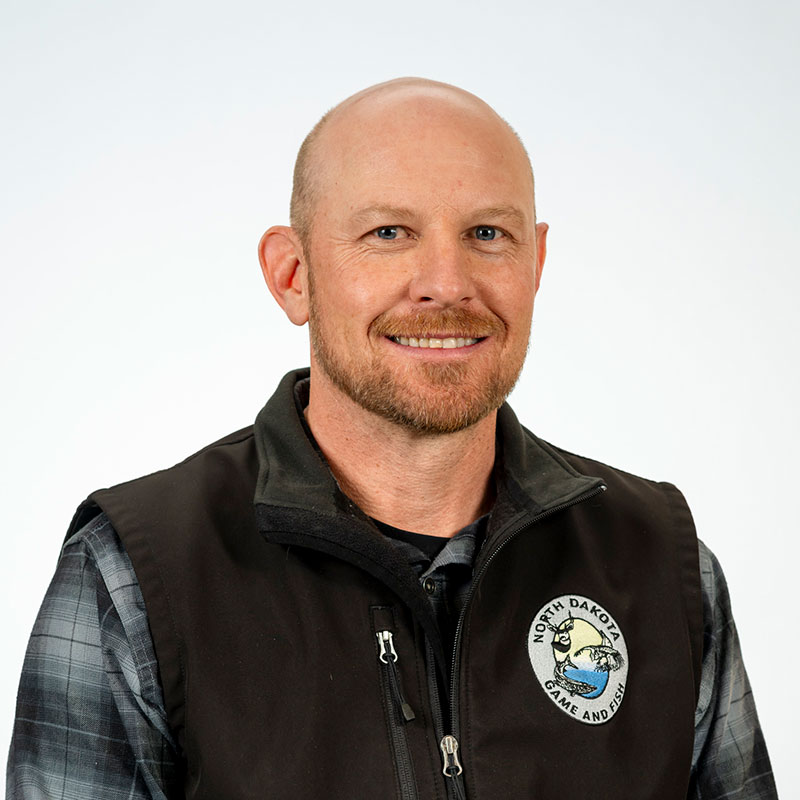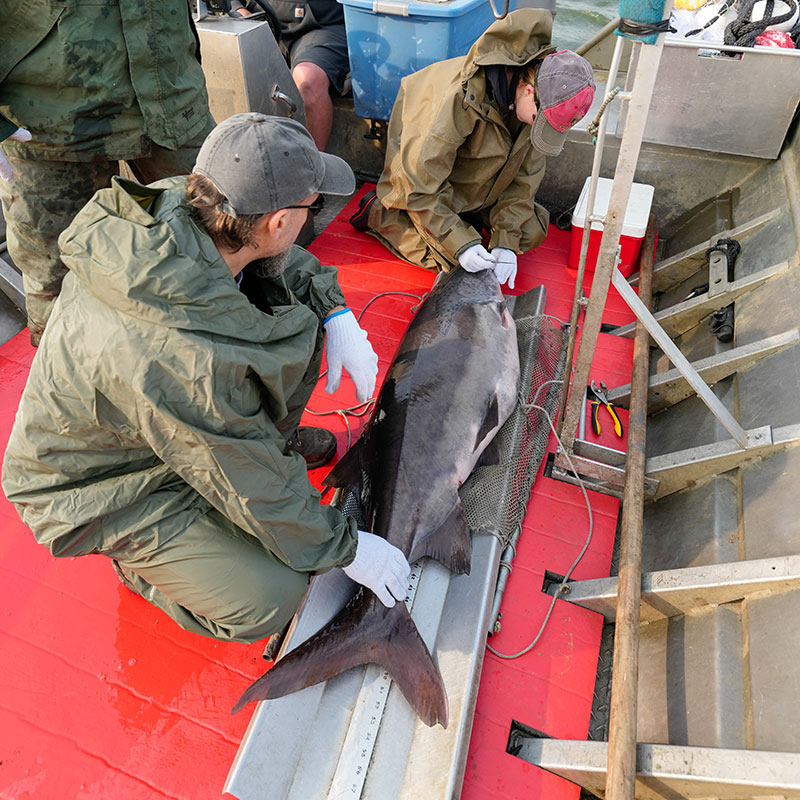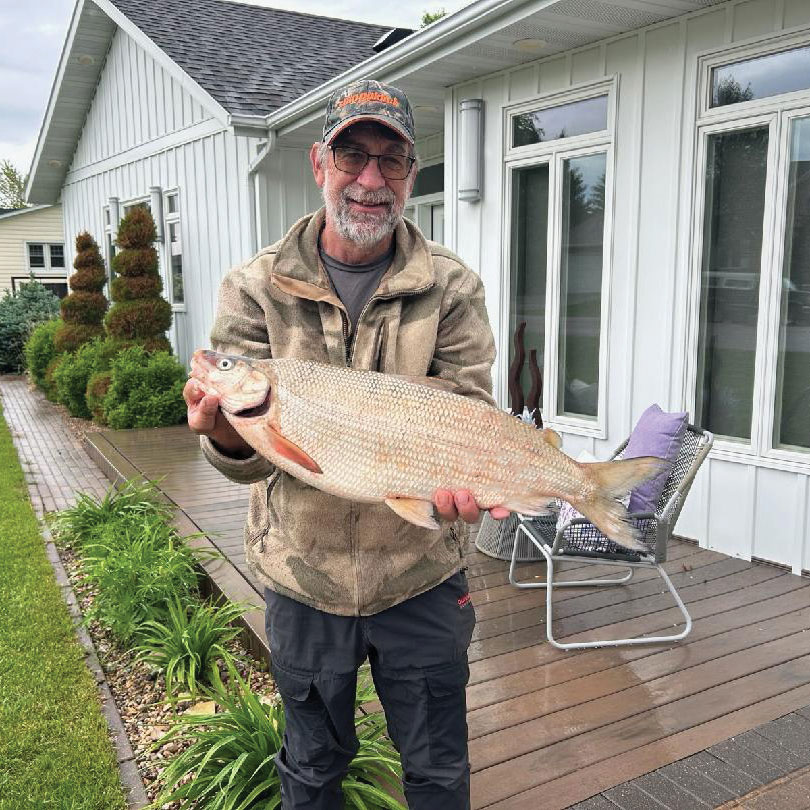The North Dakota Game and Fish Department’s 78th annual spring breeding duck survey conducted in May showed an index of about 2.66 million birds, down from 2.9 million in 2024 and 3.4 million in 2023.
The 2025 breeding duck index was the 33rd highest on record and exceeded the long-term (1948-2024) average by 7%, according to Mike Szymanski, Department migratory game bird supervisor.
“Things are continuing to decline a little bit as far as duck populations go. The mallard population estimate was down 26% from last year and is the lowest estimated mallard breeding population on our survey since 1993,” Szymanski said. “Blue-winged teal, green-winged teal and pintails also had significant population declines, whereas the declines for gadwall, shovelers and ruddy ducks were not as significant. We did have a few species – wigeon, canvasbacks, redheads and lesser scaup – that showed increases from last year on our survey.”
Szymanski said there are a few things factoring into the declines, including poor wetland conditions for early migrating species like mallards and pintails. Many of these birds, which arrived in North Dakota before the nourishing rains in May, likely spurned the state because of dry conditions and headed to search for breeding areas farther north. Also, the decline in breeding duck numbers has a lot to do with the loss of CRP and perennial grasses on the landscape used for nesting cover by ducks.
“We’ve lost so much grass on the landscape that it makes it really hard for duck populations and other ground-nesting birds to do well,” Szymanski said. “One metric we look at is going back to 1994 to 2016 when we had really good wetland conditions and a lot of grass, a lot of CRP on the landscape. Our total duck population is now down 34% from that time period’s average, and our mallard breeding population in North Dakota is down 57% from that average. Those are pretty significant declines.”
Like in year’s past, Szymanski and crew covered more than 1,800 miles of transects counting wetlands and waterfowl down to the species and social grouping on both sides of the road. This spring, the wetland count was the 52nd highest on record but was down 38% from last year.
“We do our survey based on phenology and migration ecology of ducks coming through the state and this year it happened to be timed before we got quite a bit of rain later in May. So, not having much snow melt in the spring, our wetland counts were down quite a bit,” he said. “Conditions were pretty dry and that affected how ducks settled in the state. The western third of the state was very dry and then the eastern two thirds of the state was still quite dry, but a little bit better when we ran the survey.”
Szymanski reiterated that for duck populations to rebound in North Dakota and provide good opportunities for hunters, more grass and water are needed.
“North Dakota is the duck factory of the United States and North America. We have a lot of folks relying on us to produce ducks, not just our hunters here in North Dakota, but hunters all across the Central and Mississippi flyways,” he said. “When we have poor production in North Dakota, other folks feel it as well. Unfortunately, the direction we’re going right now is smaller and smaller fall flights.”
As always, Szymanski cautions waterfowl hunters about reading too much into our survey numbers just yet. He said that while the Mid-continent duck populations aren’t what they once were, we’ll know more once the U.S. Fish and Wildlife Service releases their fall survey area results sometime in early fall.
“And we’ll see how July goes when we do our duck brood survey,” he said. “Wetland conditions are a little bit improved from where they were in early May, but they’re still not great. We likely would have had disastrous production if we didn’t get the rain we got. Hopefully, having some fair wetland conditions going into June will help us out and get a little duck production this year.”
The North Dakota Game and Fish Department encourages boaters to plan accordingly when launching and loading a boat. Here are a few simple reminders to ensure a fluent transition at the ramp.
Launching
- Don’t pull onto the ramp until your boat is ready to launch.
- Prepare for launching in the parking area. Remove covers, load equipment, remove tie downs, attach lines and put in drain plug before backing onto the ramp.
- When ready, pull in line to launch. Wait your turn. Be courteous.
Loading
- Don’t block the loading area with your boat until your tow vehicle is ready to load. Wait until you are clear of the launch area to unload gear.
- As soon as your trailer is in the water, load and secure your boat to the trailer.
- Remove boat and trailer from the water as quickly as possible.
- Get clear of the ramp. Pull into the parking area to finish securing your boat, unload gear, drain all water and inspect for and remove any vegetation. Remember to leave plugs out when transporting your boat.
Anglers can help fisheries managers by reporting information on tagged fish.
In 2025, Game and Fish Department fisheries personnel initiated a three-year walleye tagging study on Devils Lake and one-year walleye tagging studies on six other waters: Lake Addie, Griggs County; Mosher WPA, Barnes County; Horsehead Lake, Kidder County; Davis WPA, Sheridan County; Heart Butte Dam, Grant County; and the Missouri River System from Garrison Dam to Oahe Dam.
Department fisheries biologists say it’s important anglers report tagged fish from whatever waters they are fishing, no matter if their catch ends up in the livewell or back in the lake. Anglers are also encouraged to treat tagged fish just like they would treat any other fish they might have caught. Anglers practicing catch-and-release should record the tag number before releasing the fish.
Anglers can report any tagged fish they encounter by logging into their North Dakota Game and Fish Department account or use the “tagged fish reporting” feature on the Department’s website.
The number of roosters heard during the North Dakota Game and Fish Department’s 2025 spring pheasant crowing count survey was up 6% statewide from last year.
“We basically have had two really easy winters, especially as North Dakota standards, with not much snow and really nice temperatures,” said RJ Gross, Department upland game management biologist.
The primary regions holding pheasants showed 31.1 crows per stop in the southwest, up from 28.8 in 2024; 21.3 crows per stop in the northwest, down from 21.5; and 18.6 crows per stop in the southeast, up from 16.2. The count in the northeast, which is not a primary region for pheasants, was 6.5 crows per stop, up from 5 last year.
Barring untimely heavy rains, cool weather or hail, Gross expects more good news as the peak of the pheasant hatch is upon us.
“Entering the nesting season, residual grass cover looked good,” Gross said. “The timely May rains caused increased growth in nesting and brood rearing cover across the state. Combined with high overwinter survival the past two years and near ideal nesting habitat conditions, things are looking good for upland birds in North Dakota.”
Pheasant crowing counts are conducted each spring throughout North Dakota. Observers drive specified 20-mile routes, stopping at predetermined intervals, and counting the number of roosters heard crowing over a 2-minute period.
The number of pheasant crows heard is compared to previous years’ data, providing a trend summary.
Gov. Kelly Armstrong proclaimed June 7 as Prairie Day in North Dakota to a gathering of ranchers and personnel from the Game and Fish Department and the Meadowlark Initiative last month.
While recognizing their commitment to keeping native prairie on the landscape and understanding the importance of this native habitat – not just one day in June but year-round – Armstrong said, “We don’t have huge swaths of federal land and public land like other states … so any time we’re talking about maintaining grasslands, maintaining biodiversity, private property owners have to be at the table from the very first time you have those conversations.”
Cody Kologi, a Burleigh County rancher, was in attendance at the North Dakota Capitol in Bismarck when Gov. Armstrong officially made the Prairie Day announcement.
“The grasslands on our ranch are the cornerstone resource that we have here. Without it, we don’t feed our family,” he said. “We basically adopted the mindset of take care of the grasslands and the grasslands will take care of us.”
What’s good for the herd is good for the birds, as the saying goes.
“There’s so much value that grasslands provide. We have our ranchers and our landowners who are stewards of this landscape and help maintain it,” said Heather Husband, Meadowlark Initiative coordinator. “In addition, it provides resiliency for rural communities, water quality improvement, soil health improvement and natural carbon storage. And then, of course, the crucial, critical habitat for wildlife and for pollinators that are really important across the state.”
Regardless of how safe and cautious boaters are on the water, accidents happen. If a boating accident involves injury, death or disappearance of a person, an accident report must be completed and sent to the North Dakota Game and Fish Department within 48 hours of the occurrence.
If property damage exceeds $2,000, but no deaths or injuries occur, a boat operator has five days to file a report.
These reporting requirements are mandatory whether there is one or more boats involved.
A boat accident form is available online, at any Game and Fish office or by contacting a local game warden.
Photographers interested in sending photos for the North Dakota Game and Fish Department’s Watchable Wildlife Photo Contest are asked to follow the guidelines for submitting their work.
Photographers should go online. Then it is a matter of providing some pertinent information about the photo and uploading it. Doing so helps both with ease of submitting photos for the photographer and managing those images for Department staff.
The contest is now open and the deadline for submitting photos is Oct. 1. For more information or questions, contact Patrick Isakson, Department conservation supervisor, at pisakson@nd.gov.
The contest has categories for nongame and game species, as well as plants/insects. An overall winning photograph will be chosen, with the number of place winners in each category determined by the number of qualified entries.
Contestants are limited to no more than five entries. Photos must have been taken in North Dakota.
By submitting an entry, photographers grant permission to Game and Fish to publish winning photographs in North Dakota OUTDOORS, and on the Department’s website.
North Dakota state law requires youth ages 12-15 who want to operate a boat or personal watercraft by themselves with at least a 10-horsepower motor must pass the state’s boating basics course.
The course is available for home-study by contacting the North Dakota Game and Fish Department. Two commercial providers also offer the course online, and links to those sites are on the boat and water safety education page on the Game and Fish website.
While the home-study course is free, there is a fee to take it online. The online provider charges for the course, not the Game and Fish Department. The fee remains with the online provider.
The course covers legal requirements, navigation rules, getting underway, accidents and special topics such as weather, rules of the road, laws, lifesaving and first aid.
The next guide and outfitter written examination is Aug. 16 at 1 p.m. at the North Dakota Game and Fish Department office in Bismarck. Preregistration is required no later than Aug. 8 by calling the Department’s enforcement office at 701-328-6604.
In addition to passing a written exam, qualifications for becoming a guide include a background check for criminal and game and fish violations, certification in cardiopulmonary resuscitation and standard first aid, and employment by or contract with a licensed hunting outfitter.
Hunting outfitter eligibility requirements include the guide qualifications, and an individual must have held a hunting guide license for two years and must have proof of liability insurance.
Outdoor recreationists are encouraged to keep it clean this summer by packing out all trash.
All garbage should be placed in proper trash receptacles. If trash cans aren’t available, or full, dispose of trash at home.
It is not uncommon to see garbage piling up around full trash containers. Styrofoam containers are not biodegradable, but are often found wedged in cattails, drifting or washed up on shore.
Tires, mattresses and kitchen appliances have found their way to public use areas. This illegal dumping is costly to clean up and takes a significant toll on the environment. Not only does it spoil the beauty of the land, it destroys habitat, has the potential to pollute North Dakota waters and can injure wildlife.
Bill Haase, North Dakota Game and Fish Department assistant wildlife division chief, received the Conservation Change Agent Award at the Western Association of Fish and Wildlife Agencies summer meeting in Provo, Utah.
This is WAFWA’S newest award that recognizes an individual who is a catalyst for positive change, growth or innovation in an agency. It especially looks for individuals whose uniqueness and creativity allows conservation professionals to engage with new groups or resources in new ways.
Haase was noted for recognizing top talent and spearheading efforts to engage college students in working for the Department by promoting temporary, seasonal positions so they can start gaining experience.
For those turkey hunters who were lucky enough to wrap a tag around a spring gobbler, check out this installment of Cayla’s Kitchen. This enticing turkey burger recipe is perfect for a summer night on the grill, paired with a lemon basil aioli, it’s a fresh take on wild turkey meat. Simply top with your favorite veggies and enjoy. Find this easy wild game recipe and more on Game and Fish Department’s website.
North Dakota Game and Fish Department fisheries biologists have been weighing, measuring and tagging paddlefish in the Garrison Reach of the Missouri River for nearly 20 years in an effort to monitor a species that provides good insight into the health of that section of river confined upstream and down by gigantic dams. Paul Bailey, Department south central fisheries supervisor, said fisheries personnel netted and handled roughly 1,000 paddlefish in spring. Approximately 450 of those fish were tagged in previous years and 550 received new tags. Since 2006, they have tagged about 13,000 adult paddlefish between Garrison Dam and the South Dakota border. Bailey added that the number of paddlefish in this population is much lower than the population that exists above Garrison Dam in Lake Sakakawea and the Missouri and Yellowstone rivers but the number of fish between Garrison and Oahe dams appears to be holding steady.
Lonnie Liebel caught a new state record lake whitefish that had been in the books for more than 40 years. The Riverdale angler reeled in his 9-pound, 3-ounce whitefish on June 2 from the Garrison Dam Tailrace in the Missouri River. The previous record of 8 pounds, 11 ounces was established in 1984 by Bill Mitzel, a Bismarck angler who was also fishing the tailrace.


